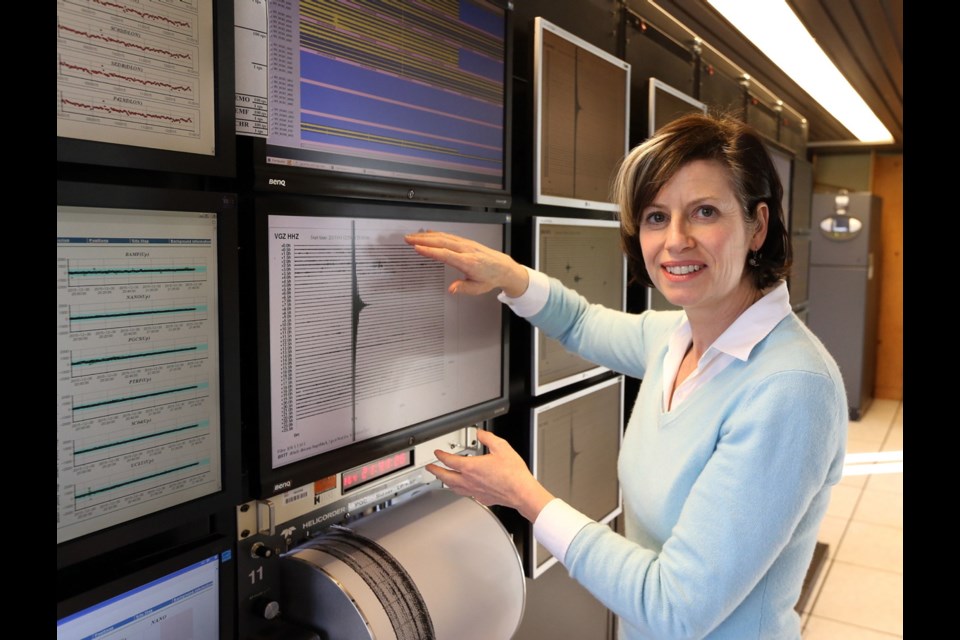An earthquake centred near Sidney Island late Tuesday shook people out of their sleep — and their complacency about the risk of a more serious seismic event in the future.
“It was felt quite broadly,” said Alison Bird, a Natural Resources Canada seismologist. “North of Nanaimo, along the Sunshine Coast, east of Abbotsford, well down into Washington state.
“A lot of people felt it partly because it was fairly close to some populated areas. Also, a lot of those people were on softer ground, which tends to amplify seismic waves, or in tall buildings.”
Bird said the earthquake is a sign of things to come.
“We are certainly in a seismic reactive area and we will get something much larger than this in the future, so it is a really good reminder for people to be prepared and have a plan.”
There were no reports of damage or injuries from the quake, which hit at 11:39 p.m.
The quake measurement from the U.S. Geological Survey started at 4.8 and went to 4.7, and calculations are still being made, Bird said. Canadian scientists have measured it at 4.3.
“We’re just using different data sets and as we get all the data in, it’ll be refined,” she said. “So probably it will be somewhere around 4.5.”
Bird said the earthquake was 50 to 60 kilometres below the surface, and was a type that rarely has aftershocks.
Esquimalt Mayor Barb Desjardins, who lives on a houseboat in West Bay, was surprised she didn’t feel the quake at all. “For the winter nights, it’s very noticeable when you get water motion because our doors will move and things like that. Last night there was nothing. No sense of motion at all,” Desjardins said.
“I’m surprised because I thought that would be my warning signal.”
Still, Desjardins and other local officials said the quake is a good reminder to have an emergency kit stocked with enough supplies to help you cope without services for at least 72 hours.
Desjardins says she not only has a kit on the houseboat but travel kits in both vehicles. “Obviously, getting off the dock will be the very first thing, particularly with any sort of tsunami risk and those sorts of things. We’re lucky here. We’re right next to DND, so any of their sirens going off we hear. But there’s also municipal systems such that if there was a risk of a tsunami, there would be a warning down here. So there’s a number of backstops.”
Victoria Mayor Lisa Helps said the earthquake woke her up, and should serve to get people thinking about emergency-preparedness kits — something some experts estimate only 20 per cent of households have.
“It’s a good warning for people,” Helps said. “I anticipate a surge in emergency-preparedness kits being put together by people today or the next couple of days, which I fully support as the mayor of this town.”
The Victoria Police Department tweeted a reminder to people not to tie the 911 service, which is reserved for more serious issues. The department’s call centre answered about 40 earthquake-related calls.
A home emergency kit should be checked twice a year and include: water (at least four litres per person, per day — half for drinking), canned foods, crackers and biscuits, honey, peanut butter, syrup and jam, salt and pepper, sugar, coffee and tea, food preparation equipment, knives, forks and spoons, disposable cups and plates and a manual can opener and bottle opener.
Supplies to have on hand include: backpack, blanket or sleeping bag, candles and matches or a lighter, clothing and shoes, flashlight and batteries, glasses or contacts, phone cards, ID, medication, radio and batteries or crank radio, toilet paper and personal hygiene supplies, whistle, special items for babies and toddlers, formula, toys, crayons and paper.



